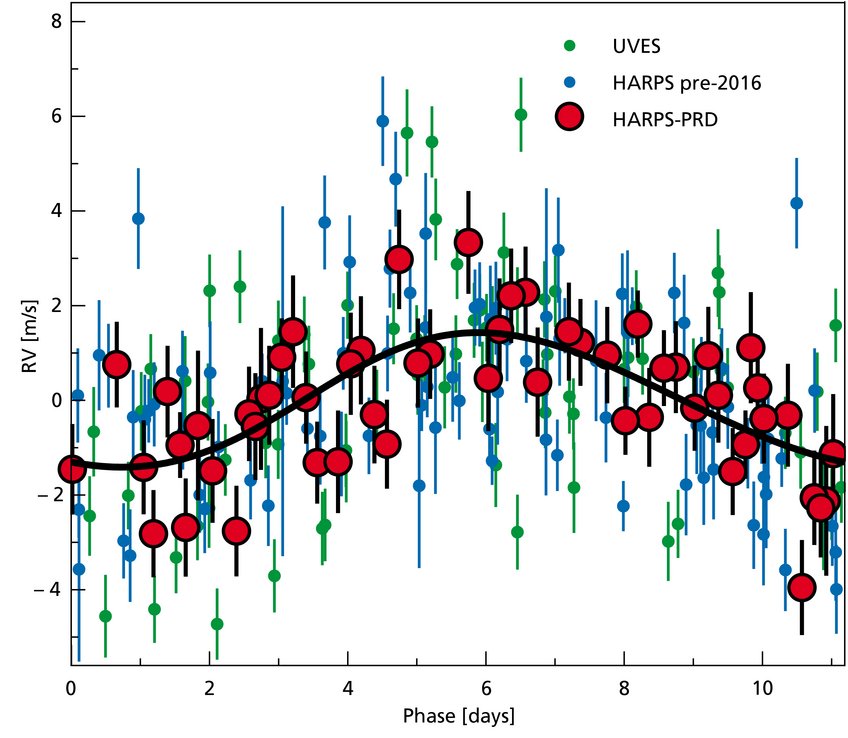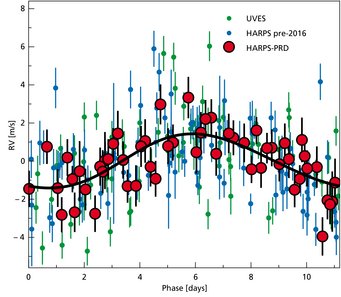Planet Found in Habitable Zone Around Nearest Star
Astronomers have discovered a planet orbiting the nearest star outside our solar system, Proxima Centauri. The planet, designated Proxima Centauri b, is in the habitable zone of its star, where liquid water could exist. The discovery is the result of a patient search using the radial velocity method, which searches for tiny wobbles of a star caused by an orbiting planet. In addition to newly acquired data, the analysis uses spectra taken by MPIA astronomer Martin Kürster and colleagues between 2000 and 2007.
As the nearest star beyond our planetary system at a distance of just over four light-years, Proxima Centauri has long been a favorite of science fiction writers – and of those taking the long view of space exploration, and wondering what our first target beyond the Solar System might be. But sending a probe to a star is one thing. Aiming at a star with a planet is much more exciting, all the more so if that planet might be able to sustain life.
Recent observations by a group of astronomers led by Guillem Anglada-Escudé (Queen Mary University of London) have found just that: a planet orbiting Proxima Centauri with an orbital period of 11.2 days, at a distance of a mere 7 million kilometers (about 5% of the Earth’s average distance from the Sun, or 1/8 of Mercury’s distance from the Sun).

The method employed for the indirect detection, the radial velocity method, allows astronomers to set a lower limit for a planet’s mass, which also serves as the best estimate for that mass. In the case of Proxima Centauri b, that mass amounts to 1.3 Earth masses, opening up the possibility that this is a planet similar to Earth.
Could Proxima Cen b sustain life?
By mass, Proxima Cen b is close to the Earth, but it remains unclear whether or not the planet might provide suitable conditions for life as we know it. Even though the planet is extremely close to its host star, its orbit lies in the region astronomers call the habitable zone, in other words: at a distance from its host star where the planetary temperature might be such as to allow the presence of liquid water. This is due to the fact that Proxima Centauri is a red dwarf star (“spectral type M5.5Ve”), and that such stars are significantly lighter and dimmer than our Sun. Proxima has just 12% of the Sun’s mass, and 0.17% the Sun’s overall brightness. Red dwarfs account for 70-80% of all stars in the solar neighborhood, and with some probability for the same fraction of stars within our home galaxy as a whole.
On the other hand, the close proximity of the planet to its host star makes it very likely that the planet is in bound rotation: one side of the planet would always be oriented towards the star, resulting in perpetual day, the other side would be in perpetual night. It is unclear how life could evolve under such adverse conditions.
A harsh environment
Red dwarf stars with one third the Sun’s mass or less are fully convective: their matter is in constant motion, similar to the way that in a boiling pot, water is constantly moving around, each portion of water mixing with all other portions.
A significant fraction of red dwarfs has a comparatively strong magnetic field, and shows substantial stellar activity, and Proxima Centauri is no exception. One consequence is the occurrence of flares: sudden releases of magnetic energy that lead to marked, but short-lived increases in the star’s brightness.
The activity of the host star, with high-energy particles and X-rays regularly hitting the planet, would seem to make conditions for possible life on Proxima Centauri b considerably more difficult.
At least some additional information about the environmental conditions on Proxima Centauri b should come sooner rather than later: Now that the planet has been detected, there is an opportunity for follow-up observations. And while a possible detection of life, or at least of conditions suggestive of the presence of life, is likely to be some decades off, these observations provide opportunities to learn about a planet around the most common type of star in our galaxy – with lessons that are interesting in their own right, for astronomers seeking a systematic understanding of planet formation in our home galaxy.
A patient search
At a time when exoplanet discoveries are common, and astronomers have found nearly 3500 such planets around stars other than the Sun, one might ask why Proxima Centauri b, our new nearest neighbor, was not discovered much earlier. There is a combination of reasons for this.
Most of the exoplanet discoveries are due to NASA’s space telescope Kepler, which is able to monitor the brightness of many different stars with high accuracy. Planets whose orbits take them between their host star and an observer on Earth periodically obscure some of the host star’s light. This allows them to be detected as astronomers monitor the host star’s brightness for tell-tale, systematic dips. While Proxima has been monitored for such dips in the past, none have so far been found. This did not preclude the existence of a planet – only of a suitably large planet whose orbit happened to be aligned in exactly the right way.
More recently, the close passage of Proxima Cen in front of two other stars, in October 2014 and February 2016, opened up the possibility for an unusual detection method known as microlensing: Had there been a planet of Proxima that had passed directly in front of one of these stars, its mass would have deflected and intensified the more distant star’s light, creating a fleeting increase in brightness based on effects of Einstein’s theory of general relativity. But again, the absence of these detections did not rule out the existence of a planet. It merely showed that such a planet was not in the right place at the right time.
On the lookout for tiny wobbles
This leaves another standard method for detecting exoplanets: the radial velocity method, which measures tiny wobbles of a star as both the star and the planet orbit their common center of mass, bound by mutual gravitational attraction. Similar to the way that the siren of a fire truck or police car changes pitch as the car passes you by, light from a star will be slightly shifted in frequency towards the blue end of the spectrum if the star approaches you, and towards the red end if the star is moving away.
Stellar spectra – the rainbow-like decomposition of the star’s light into myriads of different shades of color, or wavelengths – contain characteristic patterns of thousands of narrow, dark lines. Precision measurements of how these lines shift are redshifted and blueshifted over time can help uncover a tiny, planet-caused wobble, and thus yield indirect evidence of the presence of a planet around the star.
Several searches using this method targeted Proxima Centauri over the past decades, but no planet was discovered. However, the tell-tale wiggle is proportional to the planet’s mass, and also depends on the planet’s distance from the star, so all these searches could really do was to exclude planets in a certain range of masses and distances.
Proxima Centauri b with its comparatively small mass causes a tiny wobble that is close to the limit of what can be detected with today’s astronomical instruments. In particular, a detection takes a long series of measurements, and a stable spectrograph that can deliver precise and consistent high quality measurements over the course of years.
Precision and patience
The first ingredient of the present discovery was the spectrograph HARPS at the 3.6 m telescope of the European Southern Observatory (ESO) at La Silla Observatory in Chile, which was designed for precisely this kind of planet-hunting work and has been delivering reliable and accurate radial velocities since 2003.
In 2013, Guillem Anglada-Escudé, then at the University of Göttingen, Germany, and colleagues observed Proxima Centauri using HARPS, and found some indication of the possible presence of a planet with a period of 11.2 days, or, less likely, 13.6 days or 18.3 days. The data was not sufficiently conclusive to allow for the discovery of such a planet. The astronomers could not exclude that these were false alarms: the presence of a planet, mimicked by the ever-present noise in the observations.
The data was sufficient, on the other hand, to convince Anglada-Escudé to organize a systematic search campaign, dubbed “Pale Red Dot,” which would involve extensive additional measurements with the HARPS spectrograph as well as regular luminosity measurements using smaller telescopes, which would allow the astronomers to better take into account the influence of stellar activity. The HARPS measurements were performed on 54 nights between Jan 18th and March 30th, 2016.
Anglada-Escudé, by then at Queen Mary University of London, had also added an outreach component to the campaign, with scientists involved in the measurements writing regular blog articles and charting the campaign’s progress on social media.
The measurements began to show stronger and stronger signs of the presence of a planet. Guillem Anglada-Escudé says: "I kept checking the consistency of the signal every single day during the 60 nights of the Pale Red Dot campaign. The first 10 were promising, the first 20 were consistent with expectations, and at 30 days the result was pretty much definitive, so we started drafting the paper!”

Planet or stellar activity?
Because the red dwarf Proxima Centauri is active and has a strong magnetic field, astronomers expect that the star’s atmosphere will frequently feature dark, cooler spots: the red dwarf version of the sunspots visible on the surface of our Sun through a (suitably shielded) telescope. Such spots affect the radial velocity measurements, as well: Such star spots show up in the star’s spectrum, and can mimic the presence of a planet where no planet exists.
In order for a detection to be solid, such effects need to be taken into account. In fact, the Alpha Centauri system, a double star system very close to Proxima, and which might even include Proxima as a third component, is the subject of a cautionary tale: The discovery of what was thought between 2012 and about 2015 to be the closest planet outside our Solar system, Alpha Centauri Bb orbiting the star Alpha Centauri B, is now widely regarded as the artifact of a flawed analysis demonstrating the difficulty of extracting weak radial velocity signals from among the various noise sources present in such observations, which prominently includes the effects of stellar spots.
What clinched the detection were older observations taken by Martin Kürster (Max Planck Institute for Astronomy [MPIA]), and his former PhD student Michael Endl (now at the University of Texas at Austin) and analysed jointly with his former PhD student Mathias Zechmeister (then also at MPIA, now at the University of Göttingen) during a systematic search for companions of M stars, taken with the UVES spectrograph at ESO’s Very Large Telescope (VLT) during a period of seven years from 2000 to 2007.
Martin Kürster says: “In our earlier measurements, the signal for the planet with a period of 11.2 days is visible, but there is no way of telling whether the signal indicates the presence of a planet or is the result of random fluctuations. When combined with the new measurements, on the other hand, the earlier signal is a strong indication that what the Pale Red Dot campaign discovered is a real planet. False signals due to stellar activity would not have remained stable over the past 17 years.”
Background information
The research described will be published in G. Anglada-Escudé et al., “A terrestrial planet candidate in a temperate orbit around Proxima Centauri”, in the 25 August 2016 edition of the journal Nature.
The team includes Martin Kürster from the Max Planck Institute for Astronomy in Heidelberg, Michael Endl of the University of Texas at Austin and McDonald Observatory, Austin, Texas, USA, and Mathias Zechmeister (University of Göttingen, and formerly a PhD student of Kürster’s at MPIA) whose data from the UVES/ESO M-dwarf programme was used in the analysis.
Additional images and information can be found in the
Background information on Proxima Centauri and the Pale Red Dot project can be found on the
Download

Figure 1




